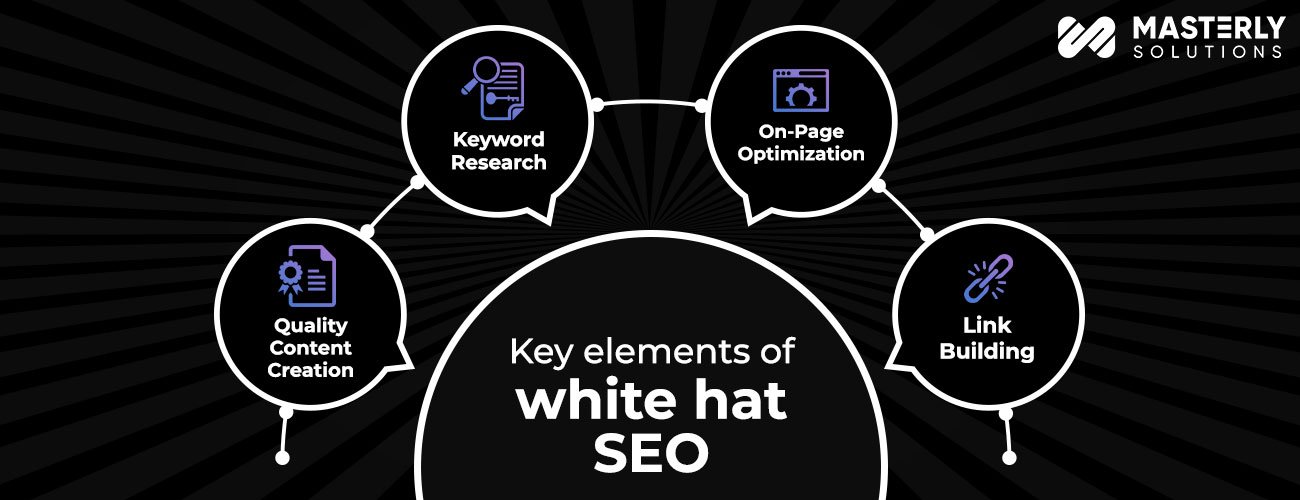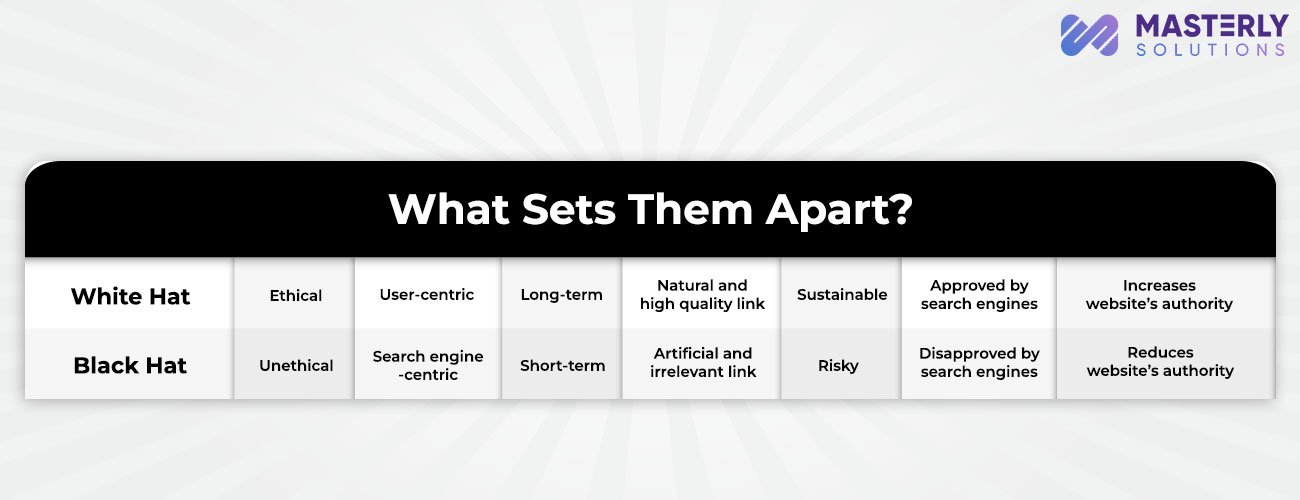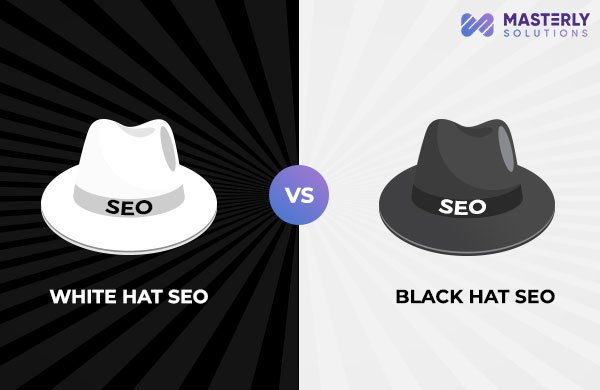
Hey there! If you’ve ever dipped your toes into the vast world of SEO and digital marketing, you might have come across the terms “white hats” and “black hats.”
No, we’re not talking about fashion accessories, we’re talking about two different approaches to optimizing websites for search engines.
While both methods aim to improve a website’s visibility and rankings on search engine result pages, they employ vastly different techniques and ethical considerations. There are so many software development company which follow white hat techniques for long-term success for themselves as well as their clients.
But, we understand that, what will fall under white hat techniques and what will fall under black hat techniques is a question that definitely pokes your mind.
So, grab a cup of coffee as we embark on a conversational journey to understand the difference between white hats and black hats in SEO.
What’s the Deal with White Hats?

White hat SEO refers to the ethical and legal tactics used to improve a website’s search engine performance. These strategies focus on creating high-quality content, optimizing website structure, and earning genuine backlinks.
It emphasizes creating valuable content for users, sticking to search engine guidelines, and employing organic tactics to attract traffic and improve rankings.
White hats believe in playing by the rules. They work energetically to provide users with a positive experience, and search engines reward their efforts with higher rankings.
Their mantra is long-term success and sustainability, building a solid foundation that stands the test of time.
Key Elements of White Hats SEO Include:

Quality Content Creation:
White hat SEO prioritizes high-quality, relevant, and engaging human-generated content that meets the needs of the target audience. This involves employing keyword research, optimizing meta tags, and developing user-friendly website structures.
Keyword Research:
Conducting extensive keyword research helps in identifying relevant keywords and phrases that visitors are looking for. Integrating these keywords naturally into website content, titles, headings, and meta tags can improve search engine visibility.
On-Page Optimization:
White hat practitioners focus on optimizing website elements such as titles, headings, URLs, and alt tags to enhance search engine visibility. They ensure that the website is easily navigable and accessible to both users and search engine crawlers.
Link Building:
White hat SEO emphasizes building authoritative and organic backlinks through legitimate means, such as guest posting, influencer collaborations, and content marketing. The focus is on fostering genuine relationships and offering value to users.
By including these white hat SEO elements, website owners can build a solid foundation for long-term success in search engine rankings while providing a positive user experience.
Unveiling the Mystery of Black Hats:

Now, let’s move to the darker side of SEO, where black hats reside. Black hat SEO encompasses techniques that go against search engine guidelines, aiming to manipulate rankings for short-term gains. Black hats are all about finding shortcuts, often resorting to tactics like keyword stuffing, hidden text, and cloaking.
They prioritize search engine bots over human users, focusing on tricking algorithms instead of providing value. While these techniques may produce quick results, they come with severe consequences, such as penalties or even getting banned from search engine results.
Whether it is mobile application or website, black hat SEO never helps you enjoy your success for a long period.
Common Black Hats SEO Practices Include:

Keyword Stuffing:
Black hat practitioners engage in excessive keyword usage, resulting in unnatural and unreadable content. This technique aims to trick search engines into ranking the website higher but offers little value to users.
Hidden Text and Links:
Black hat SEO involves hiding keywords or links within a page’s code or using the same color for text and the background, making it invisible to users but detectable by search engine crawlers.
Cloaking:
This technique presents different content to search engines and users, leading to misleading rankings. For instance, a website may display optimized content to search engine bots but irrelevant or spammy content to users.
Paid Links and Link Farms:
Purchasing links from low-quality or irrelevant websites, participating in link exchange schemes, or joining link farms (networks of websites created solely for the purpose of building links).
Private Blog Networks (PBNs):
Building a network of interlinked blogs with the sole purpose of creating backlinks to manipulate search engine rankings. PBNs are often used to create artificial authority and relevance.
Content Scraping:
Copying content from other websites and publishing it on your own without proper attribution or permission. This is done to quickly generate content and gain search engine visibility without putting in the effort to create original content.
Engaging in these tactics can lead to several consequences which are listed below. Let’s take a look at those:
Consequences and Risks of Black Hats:

Choosing a side in the white hat vs. black hat debate has significant implications. While black hat techniques may yield short-term gains, they come with severe risks.
Here are some potential consequences and risks associated with black hat SEO:
Search Engine Penalties:
To fight black hat methods, search engines constantly improve their algorithms. Websites employing such techniques face the risk of being penalized or even completely removed from search engine indexes.
Reputational Damage:
Black hat SEO disgraces a website’s reputation, making it less credible in the eyes of users and search engines. It can also lead to negative reviews and reduce brand trust.
Rebuilding Trust:
Rebuilding trust with search engines and users after being penalized for black hat SEO practices can be a difficult and time-consuming process. It requires implementing ethical SEO techniques, removing or disavowing toxic backlinks, and demonstrating a commitment to quality and user experience.
Damage to Backlink Profile:
Black hat activities such as purchasing low-quality backlinks or participating in link schemes can harm a website’s backlink profile. Search engines place a high value on the quality and relevance of backlinks. If a website is associated with spammy or irrelevant links, it can negatively impact its ranking and authority.
Loss of Organic Traffic:
Black hat SEO tactics may provide short-term gains in search rankings, but once search engines detect the manipulative techniques, the website can experience a significant loss of organic traffic. This can result in a decrease in website visibility, leads, and conversions.
Long-Term Damage:
The negative consequences of black hat SEO can have long-lasting effects. Rebuilding search engine trust, recovering lost rankings, and repairing a damaged reputation can be a challenging and time-intensive process.
It’s best to focus on sustainable and ethical white hat SEO practices to avoid these risks and build a strong online presence.
Legal Consequences:
Some black hat SEO techniques, such as content scraping or copyright violation, might lead to legal consequences. Plagiarism and copyright violations can lead to legal actions, including takedown notices, cease and desist orders, or even lawsuits.
A lot of you may have wondered, what is the difference between white hat and black hat? Let’s dive deep into this part.
What Sets White Hats and Black Hats Apart?

The key difference between white hats and black hats lies in their approach and intentions.
White hats are the virtuous knights, working diligently to create valuable content, improving website usability, and following search engine guidelines. They strive to build trust, authority, and credibility over time.
On the other hand, black hats adopt a more scheming mindset. They are willing to bend or break the rules to achieve instant gratification, but their gains are often short-lived.
Black hat techniques may boost rankings temporarily, but search engines are continuously evolving, and sooner or later, their shady tactics will be caught and penalized.
The Gray Zone:

While white hat and black hat SEO provide a clear distinction, there is also a gray area in between.
This gray zone is filled by those who may dabble in a few suspicious activities but aren’t totally committed to black hat techniques. These “gray hats” may test the boundaries, trying to gain an edge without crossing the line into unethical practices.
However, it’s important to note that the gray zone is subjective and ever-shifting. What may seem acceptable today could become black hat tomorrow as search engines refine their algorithms.
The Bottom Line:
Now that we’ve shed some light on the differences between white hats and black hats in SEO, it’s crucial to remember that honesty, integrity, and user experience should be at the core of any optimization strategy. White hat SEO may require patience and dedication, but it’s a path that leads to long-term success and sustainability.
So, whether you’re a website owner, a digital marketer, or an SEO enthusiast, make sure to don your white hat and embrace ethical practices.
And if you are struggling optimizing your website and want guidance on SEO and Digital marketing services feel free to contact us. We would be glad to help you reach your brand on another level.
Remember, good things come to those who optimize responsibly and play by the rules. Happy optimizing!
